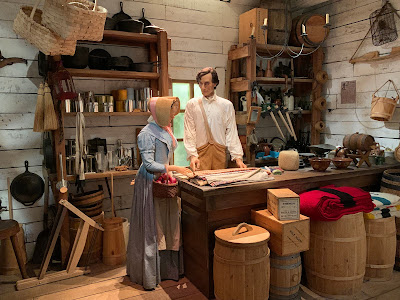We were on an Abraham Lincoln roll as we arrived in Springfield, Illinois. So we spent a few days learning even more about him.
This family was at the entrance waiting to greet us. There was some empty space so I took advantage of it.
He later served as a store clerk, a river trader, and a "rail-splitter" so he was used to hard physical labor.
Mary Todd, even more so than her husband, was a staunch abolitionist. She supported his political career as he rose from the Illinois legislature to become one of the country's most charismatic political orators to speak against slavery. Even early on in his career, Lincoln received death threats from pro-slavery southerners, and Mary Todd was labeled a traitor to her southern Kentucky roots. During the Civil War, she felt a deep sense of estrangement and tragedy; most of her male family members fought on the side of the Confederacy. To make matters worse, she was often criticized in newspapers and social circles for what was perceived as undue influence on her husband's political appointments.
The stamp used by Lincoln to imprint the presidential seal in wax on confidential letters and official documents.
One reporter went so far as to blame Ms. Lincoln for causing the president's health to deteriorate, giving him a gaunt frame and hollow cheeks. Those features were more likely caused by a debilitating wasting syndrome called Marfan's disease and the burden of governing a nation at war with itself.
Many interesting items were on display.
One of the most tragic experiences of the White House years was the death of their son, Willie.
The displays were very life like. At the end of an otherwise routine meeting, Lincoln surprised his cabinet by reading his draft of the Emancipation Proclamation. He said at the time that his mind was made up on what he was going to say and that he simply wanted their input on how best to implement the Proclamation. The Proclamation freed slaves in enemy territory and was sure to be controversial because it only applied to states that had seceded from the US leaving slavery untouched in the loyal border states. After listening to his cabinet's concerns, Lincoln decided to wait before issuing the document to the public.
And then it was on to that fateful day at Ford's Theater. A chair from the orchestra level.
And the display showing the box where Mrs. and Mrs. Lincoln sat.
No social media - it makes me wonder how long it took for people to hear the news.
Of course, Mary was devastated.
Some post assassination discoveries.
Kennedy didn't have a Funeral Train even though Lincoln did and it criss-crossed the country.
Don't worry - more on our friend Abe with tomorrow's visit.



































I doubt I'll ever get here. But I would like to.
ReplyDeleteYou need to. There is so many Lincoln sites in Springfield.
Delete